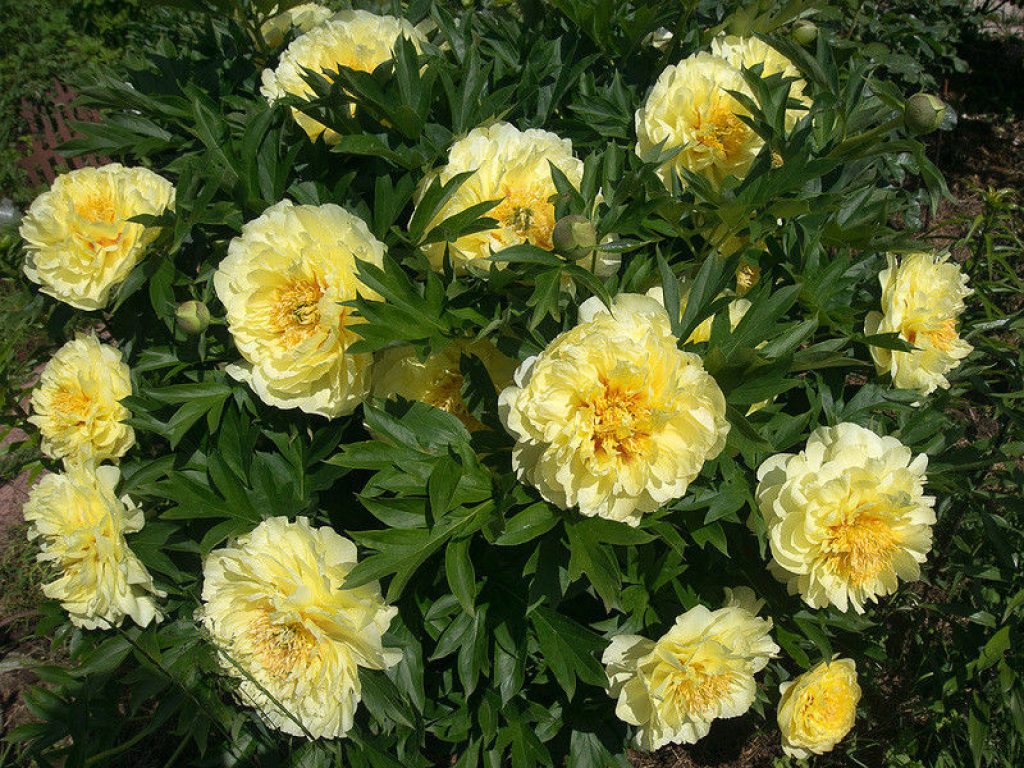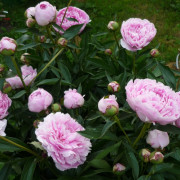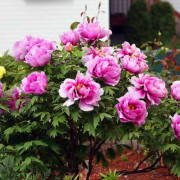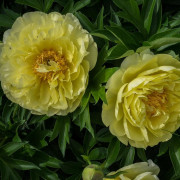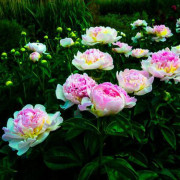Yellow peonies - the best varieties and care for them
Content:
Yellow peonies are undeservedly overlooked, preferring their white and pink counterparts. Lemon-colored peonies are a unique plant, whose juicy color and rich aroma will decorate any garden. The rules for growing these flowers are quite simple, and a huge selection of varieties will suit the taste of any grower.
Brief description and characteristics
The culture was bred by Japanese breeders more than half a century ago from a combination of tree and herbaceous species. As a hybrid, it differs somewhat from the popular red, white and pink varieties both in terms of planting and the duration of flowering.
On average, yellow peonies delight gardeners for 3-4 years. The shrub reaches a height of 90 cm – 1 m, flowers can grow up to 20 cm in diameter. Flowering period: late May - early July, depending on the variety.
Application in landscape design
Peonies have always been popular in landscape design. It is the yellow shades that look especially beneficial on the site. This is one of the few plants that can be planted in a separate flower bed on a raised or green lawn.
Yellow peonies can become the central composition of the garden if you place them at the front door of the house. Designers advise planting them in resting places near your favorite rocking chair or near an open kitchen. Flowers can exist next to garden scented geraniums or white tansy. Such a neighborhood will favorably emphasize the yellow color, but will not hide the dignity of other plants.
Popular varieties
The world's first yellow peonies were very dull and lost their color in the sun, turning into a kind of white congeners. Thanks to modern breeding, all three types - herbaceous, tree-like and hybrid - can have any shades: from pale yellow to honey.
Herbaceous
Herbaceous yellow peony is one of the most widespread varieties in Russia. It includes 7 representatives and has a delicate aroma and natural creamy yellow color.
Varieties:
- Peony yellow variety Lemon-chiffon. It was bred in the Netherlands and quickly became popular all over the world. Due to its rich tone with a lemon shade and incredible height, it regularly occupies a leading position in the rating of flowers. The flower diameter reaches 22 cm.
- Golden chariot. It is considered one of the favorite flowers in China. The bud is terry, has a natural yellow color, reaches 15 cm in diameter, resembling a crown in shape. It blooms in mid-season and is ideal for cutting.
- Variety Golden halo. Pale yellow in color. It grows no more than 70 cm, the diameter of the flower is up to 13 cm. It is unpretentious when adjacent to other flowers.
- Sunny fight. Terry, has a delicate creamy color. Plant height - up to 75 cm, flower diameter - up to 16 cm.
- Golden Wheat. Differs in a yellow-green tint, a spreading shape of bushes and a height of up to 90 cm. The diameter of the flower is up to 15 cm. It begins to bloom in May. Unpretentious in terms of soil composition, even in coniferous areas.
- Gold Mine. Leads in the beginning of flowering. This double flower has a light yellow color and a diameter of up to 16 cm. It reaches a height of 80-90 cm. It is frost-resistant.
Tree-like
Tree peonies got their name because of the similarity in shape with small trees. They are sometimes called deciduous shrubs. They can grow up to 2 m. The stems grow with renewed vigor every season and do not wither in the winter.
Popular varieties:
- Variety Midday heat. It has a pronounced lemon color, rich aroma and a height of up to 120 cm. It blooms from late June to mid-July. In the hot summer, flowering can be expected twice.
- Yellow Yao. One of the most frost-resistant species. He is less susceptible to disease than others. It can start flowering from mid-April. Usually one plant has about 50 flowers per season.
- Gold Placer. One of the brightest yellow peonies. It has an orange-honey color with pink splashes. It begins to bloom in early June.
- Variety Akademik Sadovnichy. The lowest of the treelike. Its stems reach 1 m in height. Flowers have a pale yellow color with a pink tint.
- Flowers Souvenir de Maxim Cornu. They have a rich creamy yellow color with a pink border around the edges. Flowering begins no earlier than mid-July. When cut, it is most resistant to wilting.
- Peony Kuindzhi. It has a calm yellow color with a red tint closer to the middle. It is the tallest of the tree-like ones - up to one and a half meters. There are a lot of flowers on the bush, they quickly replace each other and fall off.
Hybrid
These yellow peonies are a unique combination of the best qualities of herbaceous and hybrid species. They are easy to plant and maintain, but have lush, long-lasting blooms and rich colors.
Popular varieties:
- Viking Full Moon variety. One of the most unpretentious. It has the shape of a herbaceous bush. The flowers are medium-sized, yellow-green in color with a bright burgundy disc in the center.
- Bartzella. One of the most popular varieties. Differs in a tea shade with red blotches and huge double flowers. The herbaceous shrub reaches a height of 100 cm. It usually blooms in early July.
- Going Bananas. It resembles a banana in color and differs in simple flowers no more than 20 cm in diameter. The height of the bush is about 65-70 cm. Flowering begins closer to mid-July.
- Variety Singing in the Rain. One of the most expensive and luxurious. The shade resembles the pulp of a grapefruit, the aroma is light and unobtrusive. The height of the stems is up to 80 cm, the diameter of a semi-double flower is up to 20 cm.
- Canary Diamonds. Differs in lush flowering and bush height up to 1 m. The color is rich, yellow with a cream shade. It is versatile in planting, it can grow in almost any soil, it is resistant to frost.
- Border Charm. It is distinguished by a creamy shade of lush double flowers with a diameter of 20 cm. The height of the bush is 50-70 cm. The pronounced aroma resembles the smell of citrus fruits. Blooms profusely, hardy.
- Yellow Crown variety. It is the yellowest of all the varieties described above, flowers reach 15-17 cm in diameter. Yellow Peony begins flowering in mid-May and has a long flowering. When cut, it decorates bouquets for 7-10 days on average.
Basic rules for planting and growing
In open ground, these yellow flowers are planted using root cuttings branched from the bush. The division operation is carried out independently or a ready-made stalk is bought. When buying, they are guided by a 3-4-year-old peony cut with 2-5 growth points (or buds). The seedling should not have suspicious growths, be too dry or wet. It is better if the root system is about 20 cm long.
Timing and features of landing
Planting usually occurs in the fall, around mid-September - a month before the start of frost. The root system should sprout before the onset of cold weather.
Peonies planted in spring have a weak, undeveloped root system that is prone to disease. This is due to the fact that in the spring the peony's task is to bloom, so all its power goes to the formation of buds and leaves. Planting in spring is possible from mid-April to early May. It depends on the timing of flowering. For example, the Yellow peony begins to form buds already at the beginning of May, so it is planted no later than the beginning of April.
For successful growth and flowering, you need to choose the right location. Places rich in sunshine throughout the day are suitable. You can not place a flower bed closer than 1 m to the walls of buildings and structures on the site. The shade is destructive as it slows down flowering.
The recommended distance between bushes is from 1 to 1.5 m. The landing site should not be flooded during the period of rains or melting snow.
Particular attention is paid to the choice of soil. Cultivated loamy is best suited. The key recommendation will be good moisture capacity and drainage of the soil for planting. The soil should not be excessively moist.
The seedling should be carefully examined before planting. Damage or signs of rot are trimmed with a sharp knife and then treated with wood ash. If the seedling is dry, planting it is pointless.
Step-by-step instructions for planting yellow peonies
- Dig a hole up to 1 m deep, the bottom of which is lined with a drainage layer (gravel or garden brick).
- Fertilizer is prepared right in the pit. It can be specialized for perennial plants or a mixture of humus, ash and Superphosphate with earth.
- A soil is applied to the fertilizer along the edges.
- A seedling is placed in the pit, straightening its roots to the sides and down. The buds on the seedling should be 3-5 cm underground.
- A little river sand is poured around the seedling and carefully covered with soil.
- Form a watering circle and water gently.
Care rules
After planting, the flower is watered moderately, avoiding excess moisture. If the peonies were planted in the fall and there are heavy rains, then additional moisture is not required. In spring and summer, peonies are watered on average once every 7-10 days. Watering usually ends in late August - early September.
Gentle loosening of the soil around the bush is necessary both after watering and after rain, after about 2-3 hours. Fertilize the plant after the active flowering season, in August - September. In October - November, during the frost period, the plant is cut to a height of 10-15 cm and covered for the winter.
Particular attention is paid to mulching - the process of feeding with organic fertilizer. In the first year of planting, peat or humus is scattered around the roots of a yellow peony. In exceptional cases, horse manure is used.
For the purpose of preventive treatment, stove or wood ash is added to the soil around the rhizome, which protects against many diseases and parasites. If necessary, the plant can be mulched with compost every fall.
Flowering features
The main difference between the yellow peony and other varieties is the long period of relatively abundant flowering. The time frame depends on the variety and planting site. On average, they bloom from mid-May to mid-July for 1 to 3 weeks: non-double - 5-10 days, double - 15-20 days, semi-double - up to 2 weeks. The peak of active flowering of most varieties occurs in the first two weeks of June.Rare varieties can reach the beginning of August.
In the first two years after planting, it is recommended to pick the buds as soon as they appear. This helps the plant develop a strong root system so that it can have lush, large flowers in the years to come.
During the flowering period, special attention is paid to care: they feed them with special fertilizers with potassium or phosphorus and water them regularly.
If the flowering of peonies does not occur, the reasons may be:
- Incorrect planting of the plant. The analysis takes into account the composition and moisture content of the soil.
- Wrong location. The parameters of the location of the flower and the possibility of transplanting are evaluated.
- Lack or oversupply. Top dressing should be done according to the regime.
- Overly active previous flowering.
- Plant age: usually 5-6 years after planting, flowering activity decreases.
- Fungus and other diseases.
- Bare rhizome. In this case, add nutritious soil to cover the roots.
Yellow peonies after flowering
Each flowering period should alternate for shrubs with properly organized rest and rest. To get a decent flowering next year, you need to follow these steps:
- Transfer. It is carried out once every 2-3 years to renew the soil. If the plant begins to wilt and give few flowers, the transplant is performed immediately after the main flowering stage.
- Pruning yellow peonies immediately after flowering is not allowed. They are cut towards the end of September.
- Preparing for winter. The root system is fertilized and some varieties are covered. Most yellow peonies are hardy.
Diseases, pests and ways to control them
The main pests of the flower are viruses and fungi. Prevention of their appearance is the observance of the rules of care and careful examination of the plants. Damaged areas of the flower are cut off with a sharp knife and burned. In order not to start insects, flowers are planted as far as possible from potatoes, raspberries and strawberries. It is necessary to spray them with special solutions against aphids, bronzes and caterpillars.
Yellow peonies are wonderful plants that will appeal to any gardener. They are unpretentious, frost-resistant, easy to care for, and consistently delight their owners with chic flowers of sunny shades.

